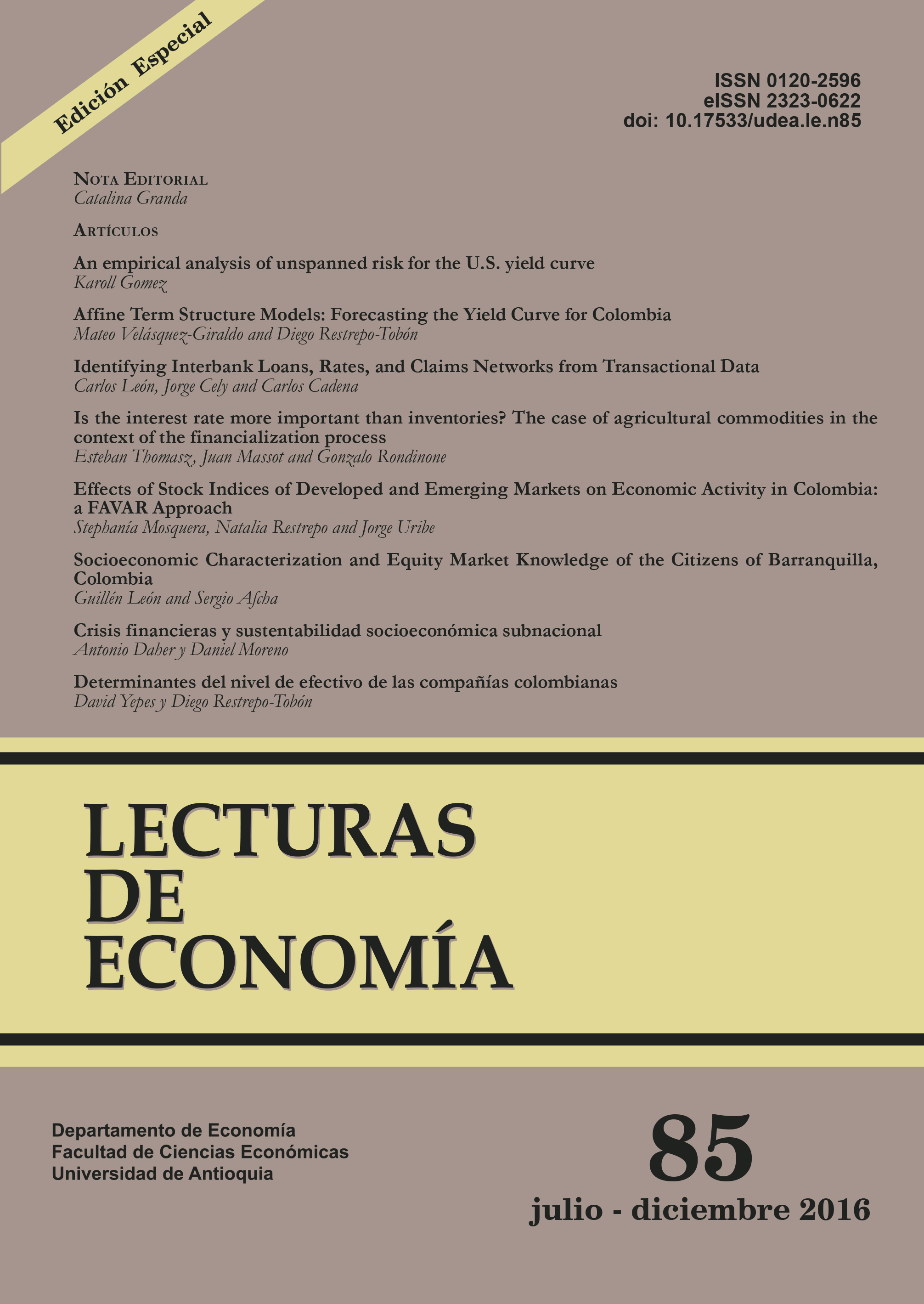Effects of Stock Indices of Developed and Emerging Markets on Economic Activity in Colombia: a FAVAR Approach
DOI:
https://doi.org/10.17533/udea.le.n85a05Keywords:
stock prices, financial conditions indices, factor-augmented vector autoregression, dynamic factor modelsAbstract
We analyze the effect of global financial conditions of developed and emerging economies on economic activity in Colombia. To accomplish this task, we estimate financial conditions indices for the stock markets of developed and emerging countries using principal components analysis. Then, we include the estimated indices as regressors in a traditional vector autoregression (VAR) that includes series of economic activity in Colombia; that is, we carry out a factor-augmented vector autoregression (FAVAR) analysis with one unobservable factor and one observable variable accounting for real economic activity to evaluate the influence of international financial conditions on macroeconomic variables in Colombia. Using monthly data, we find that the stock market conditions of emerging economies have a positive effect on macroeconomic performance in Colombia.
Downloads
References
Angeloni, Ignazio & Faia, Ester (2009). “A Tale of Two Policies: Prudential Regulation and Monetary Policy with Fragile Banks”, Kiel Working Papers 1569. Kiel Institute for the World Economy.
Bai, Jushan & Ng, Serena (2002). “Determining the Number of Factors in Approximate Factor Models”, Econometrica, Vol. 70, No. 1, pp. 191– 221.
Bai, Jushan & Ng, Serena (2004). “A Panic Attack on Unit Roots and Cointegration”, Econometrica, Vol. 72, No. 4, pp. 1127–1177.
Bai, Jushan & Ng, Serena (2008). “Large Dimensional Factor Analysis”, Foundations and Trends in Econometrics, Vol. 3, No. 2, pp. 89–163.
Balakrishnan, Ravi; Danninger, Stephan; Elekdag, Selim & Tytell, Irina (2009). “The Transmission of Financial Stress from Advanced to Emerging Economies”. Working paper 09/133. International Monetary Fund, Washington, DC.
Bernanke, Ben; Boivin, Jean & Eliasz, Piotr (2005). “Measuring the Effects of Monetary Policy: A Factor-Augmented Vector Autoregressive (FAVAR) Approach”, The Quaterly Journal of Economics, No. 1, pp. 387-422.
Brave, Scott & Butters, Andrew (2011). “Monitoring Financial Stability: a financial conditions index approach”, Economic Perspectives, No. 1, pp. 22-43.
Christiano, Lawrence; Motto, Roberto & Rostagno, Massimo (2010). “Financial Factors in Economic Fluctuations”, Working Paper Series 1192. European Central Bank.
Claessens, Stijn; Kose, Ayhan & Terrones, Marco (2011). “Financial Cycles: What? How? When?”, IMF Working Paper 76. International Monetary Fund.
Cúrdia, Vasco & Woodford, Michael (2010). “Credit Spreads and Monetary Policy”, Journal of Money, Credit and Banking, Vol. 42, No. 1, pp. 3-35.
Gerdrup, Karsten & Hammersland, Roger (2006). “Financial Variables and Developments in the Real Economy”, Economic Bulletin, Vol. LXXVII, pp.133-146.
Gómez, Esteban; Murcia, Andrés & Zamudio, Nancy (2011). “Financial Conditions Index: Early and Leading Indicator for Colombia”, Reporte de Estabilidad Financiera, March 2011. Banco de la República.
Hatzius, Jan; Hooper, Peter; Mishkin, Frederic; Schoenholtz, Kermit & Watson, Mark (2010). “Financial Conditions Indexes: A Fresh Look after the Financial Crisis”, NBER Working Paper 16150. National Bureau of Economic Research.
Meh, Césaire & Moran, Kevin (2010). “The Role of Bank Capital in the Propagation of Shocks”, Journal of Economic Dynamics and Control, Vol. 34, No. 3, pp. 555-576.
Pagan, Adrian. (1984). “Econometric Issues in the Analysis of Regressions with Generated Regressors”, International Economic Review, Vol. 25, No. 1, pp. 221-247.
Peña, Daniel & Poncela, Pilar (2006). “Nonstationary Dynamic Factor Analysis”, Journal of Statistical Planning and Inference, Vol. 136, No. 4, pp. 1237-1257.
Prasad, Eswar; Rogoff, Kenneth; Wei, Shang-Jin & Kose, Ayhan (2004). “Financial Globalization, Growth, and Volatility in Developing Countries”, NBER Working Paper 10942. National Bureau of Economic Research.
Stock, James & Watson, Mark (2002a). “Macroeconomic Forecasting Using Diffusion Indexes”, Journal of Business and Economic Statistics, Vol. 20, No. 2, pp. 147-162.
Stock, James & Watson, Mark (2002b). “Forecasting Using Principal Components from a Large Number of Predictors”, Journal of the American Statistical Association, Vol. 97, No. 460, pp. 1167-1179.
Stock, James & Watson, Mark (2005). “Implications of Dynamic Factor Models for VAR Analysis”, NBER Working Paper 11467. National Bureau of Economic Research.
Stock, James & Watson, Mark (2006). “Predicting with Many Factors”. In: G. Elliott & C. Granger & A. Timmermann (Ed.), Handbook of Economic Forecasting, Vol. 1 (pp. 515-554). Amsterdam: Elsevier
Uribe, Jorge Mario & Fernández, Julián (2014). “Financial Bubbles and Recent Behavior of the Latin American Stock Markets”, Lecturas de Economía, No.81, pp. 57-90.
Published
How to Cite
Issue
Section
License
This page, by Universidad de Antioquia, is licensed under a Creative Commons Attribution License.
Authors who publish with this journal agree to retain copyright and grant the journal right of first publication, with the article licensed under a Creative Commons Attribution-NonCommercial-ShareAlike License allowing others to share it as long as they acknowledge its authorship and original publication in this journal.
Authors can enter into separate, additional contractual arrangements for the non-exclusive distribution of the journal's published version of the work (e.g., post it to an institutional repository or publish it in a book), provided that these arrangements be not for profit and the journal be acknowledged as the original source of publication.
Authors are permitted and encouraged to post their papers online (e.g., in institutional repositories or on their websites), as it can lead to valuable exchanges as well as greater citation of the published work.







